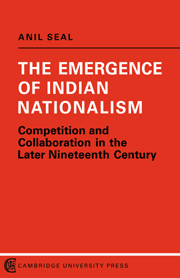Book contents
- Frontmatter
- Contents
- List of Maps and Tables
- Preface
- Abbreviations
- India: British Provinces and Native States
- 1 Political India
- 2 The Political Arithmetic of the Presidencies
- 3 The Rewards of Education
- 4 The Policies of the Rulers
- 5 The Politics of the Associations
- 6 The Politics of Union
- 7 The Muslim Breakaway
- 8 Perspectives
- Appendices
- 1 Growth of Education at the Universities of Calcutta, Bombay and Madras, 1857–88
- 2 The Employment of Graduates
- 3 Opportunities in the Public Service
- 4 Membership of the British Indian Association
- 5 Growth of the Press in Bengal and Bombay, 1878–88
- 6 Congress Resolutions, 1885–8
- Glossary
- Biographical Notes
- Bibliography
- Index
5 - Growth of the Press in Bengal and Bombay, 1878–88
Published online by Cambridge University Press: 23 November 2009
- Frontmatter
- Contents
- List of Maps and Tables
- Preface
- Abbreviations
- India: British Provinces and Native States
- 1 Political India
- 2 The Political Arithmetic of the Presidencies
- 3 The Rewards of Education
- 4 The Policies of the Rulers
- 5 The Politics of the Associations
- 6 The Politics of Union
- 7 The Muslim Breakaway
- 8 Perspectives
- Appendices
- 1 Growth of Education at the Universities of Calcutta, Bombay and Madras, 1857–88
- 2 The Employment of Graduates
- 3 Opportunities in the Public Service
- 4 Membership of the British Indian Association
- 5 Growth of the Press in Bengal and Bombay, 1878–88
- 6 Congress Resolutions, 1885–8
- Glossary
- Biographical Notes
- Bibliography
- Index
Summary
The following tables give details about the number of Indian-owned newspapers in Bengal and Bombay, their circulation, the languages in which they were published and their place of publication. During the decade, the number of vernacular newspapers in Bengal increased from thirty-nine to sixty-two, but more significant was their rise in circulation, particularly after 1883 (table 61). In addition to these newspapers there was a large English-language press, based almost entirely in Calcutta, which in 1881 consisted of sixteen newspapers—some of them owned by Indians—with a total circulation of about 15,000. Tables 62 and 64 show that, as the press expanded, the extraordinary predominance of Calcutta was increasing. In 1878, out of a total circulation of 23,893 in the Presidency, Calcutta newspapers accounted for 14,242; in 1888 of a total circulation of 77,190, Calcutta newspapers accounted for 67,070. This vividly demonstrates the dominance of the metropolis and shows how much the mofussil depended on it for its political lead. Tables 62 and 64 also show that there was an increasingly large number of newspapers published from the districts but that they had a restricted readership. An indication of the limitations on up-country journalism is that the Amrita Bazar Patrika, successfully launched in Jessore, then became irresistibly drawn to the city.
In Bombay on the other hand, there was no equivalent concentration of papers in the capital. In 1878 more than half the total circulation in western India had been captured by the newspapers of Bombay city; by 1888 they possessed considerably less than half, and Poona in particular had developed a lively press of its own.
- Type
- Chapter
- Information
- The Emergence of Indian NationalismCompetition and Collaboration in the Later Nineteenth Century, pp. 366 - 372Publisher: Cambridge University PressPrint publication year: 1968

